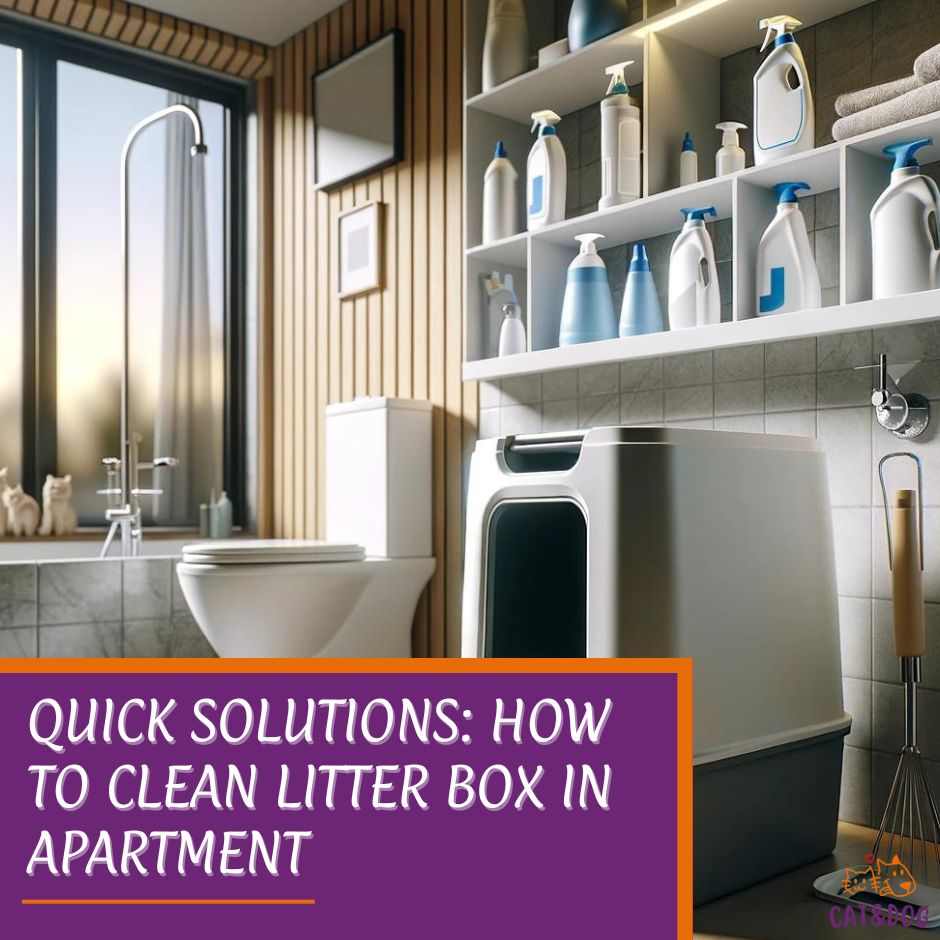Maintaining a clean litter box is critical for cat owners, especially when living in the limited confines of an apartment.
In an apartment, it’s important to clean your cat’s litter box at least once a day to prevent odors from spreading in the confined space.
Regular cleaning helps maintain hygiene and ensures your cat has a clean and comfortable litter box to use.
Have you ever wondered how often you should be scooping or what the best way to manage odors is? It’s not just about your nose; it’s also about keeping your furry friend happy and healthy.
Think about it—would you want to navigate a messy bathroom?
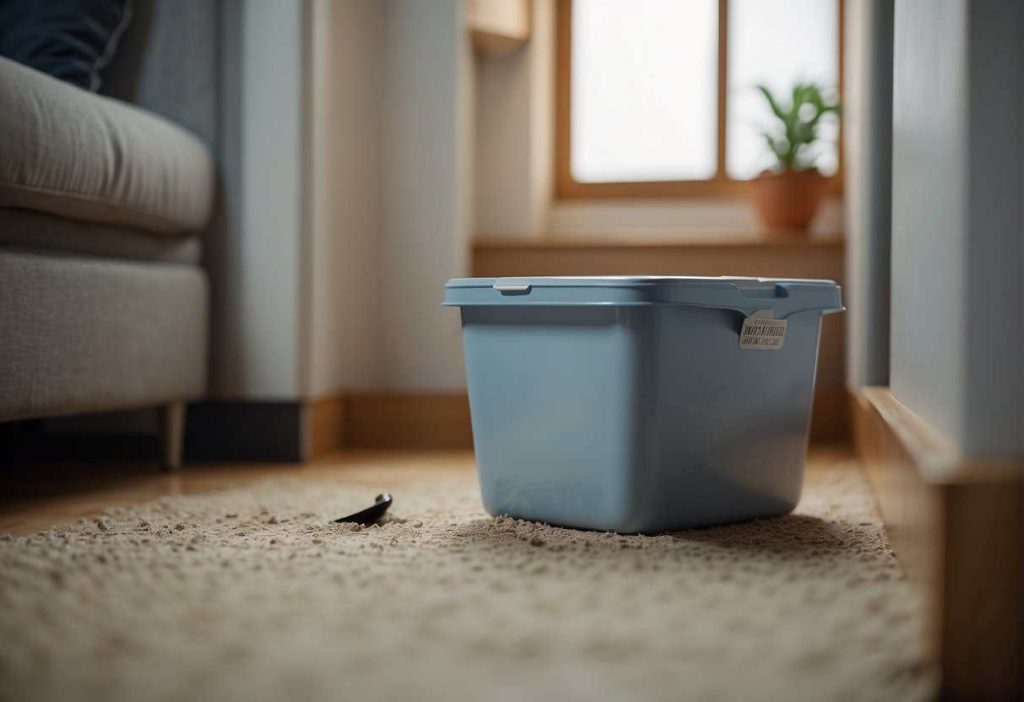
Clever solutions for litter box management can make the task less daunting and more efficient.
Whether you’re dealing with a tiny space or just looking for a smarter way to keep things tidy, there’s always a trick or two that can help.
Cleaning the box is a task that seems simple, but with the right techniques and a bit of know-how, it can be seamless and unobtrusive, much like artfully tucking away that box in a corner no one ever notices.
Key Takeaways
- Proper litter box cleaning promotes the well-being of cats and ensures a pleasant living space.
- A range of strategies and tools simplifies litter box maintenance in apartments.
- Regular cleaning, odor control, and an aesthetic setup contribute to effective litter box management.
How to Clean Litter Box in Apartment: Preparation Guide
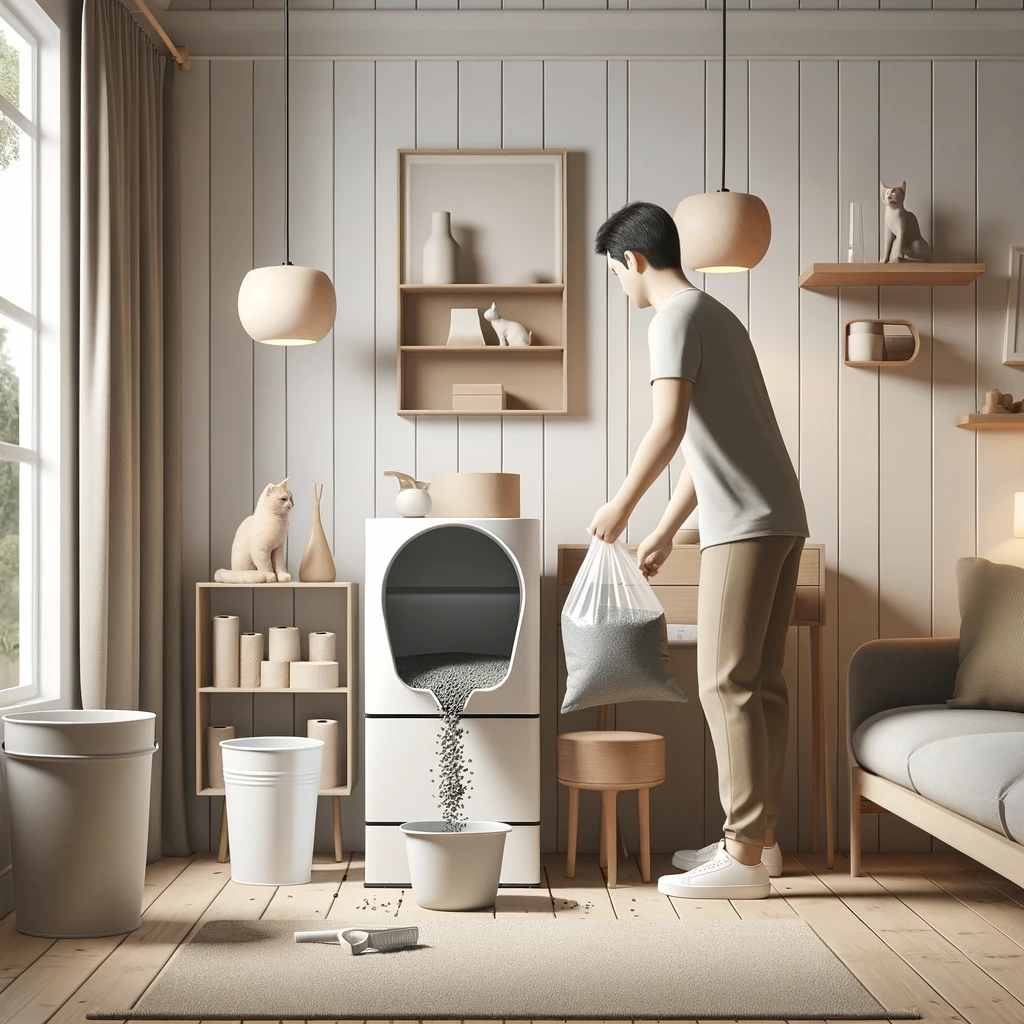
Before you dive into cleaning your cat’s litter box, it’s a good idea to get all your cleaning ducks in a row, don’t you think?
You want to make the process as smooth as a kitten’s fur, so here’s a checklist to keep you on track:
- Litter scoop: Your trusty sidekick in the battle against litter clumps.
- Trash/Garbage bag: For prompt disposal – think of it as a magic portal for litter waste.
- Gloves: It’s not just a fashion statement, it protects your hands too!
- Cat-safe disinfectant: Because your furry friend deserves a safe and clean environment. (1)
- Scrub brush or sponge: These little scrubbers are the muscle behind the cleanliness.
- Paper towels or old rags: For the final touch in drying and dusting.
- Baking soda: A sprinkle here and there keeps the odors at bay. (2)
Safety Tips Before You Start:
Remember, you’re the superhero in your cat’s story, so suit up! Don your gloves to keep things hygienic, and maybe even don a mask if you’re feeling extra.
Your goal is to prevent any unwanted germs from crashing the party. Ready for action? Your litter box won’t know what hit it!
Keep in mind, that making this a regular gig will not only keep you from the dread of a full-blown clean-up but also keep your feline overlord purring with pleasure.
Step-by-Step Guide to Cleaning Your Litter Box
Daily Maintenance Tips
Ever catch a whiff of something not so fresh in your apartment? No worries – with a bit of daily upkeep, your kitty’s box can stay pretty odor-free.
Every day:
- Scoop out clumps and solids into a sealable bag.
- Toss it in the trash, ideally, a can with a lid to contain smells.
- Top off the box with a bit of fresh new litter to keep the level consistent.
Deep Cleaning Process
Once a week, it’s time for a clean slate. Or should I say, a clean box? Follow these steps:
- Emptying the Litter Box
- Start by emptying all the litter into a trash bag. Seal it up tight and bid it goodbye!
- Washing the Litter Box
- Now, bathe that empty box. A mild soap and water solution does the trick.
- For tough germs, a bleach mix (1 part bleach to 32 parts water) can be used – just make sure you rinse well!
- Drying and Refilling
- After washing, dry the box thoroughly with paper towels.
- Humidity is a bacteria’s playdate, and we’re not inviting them over.
- Then, fill ‘er up with fresh litter to the recommended level, typically about 2-3 inches.
Remember, these are just guidelines to keep that feline bathroom sparkling. Have fun with it – maybe hum a little tune as you clean?
And just think of that purring, happy cat as your reward for a job well done!
Health Considerations and Best Practices
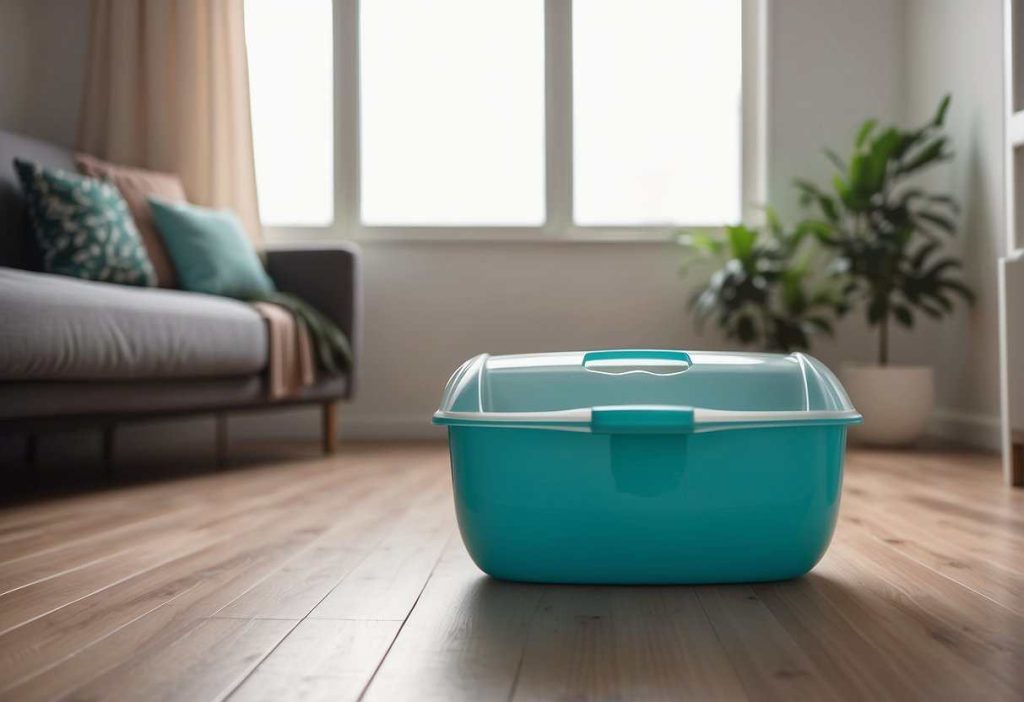
Let’s tackle those litter box cleaning practices that will keep both you and your pet in the pink of health!
Why Worry About Germs?
Cats can carry bacteria like Salmonella or parasites such as Toxoplasma gondii, which may cause illness in humans, so it’s crucial to stay vigilant. (3)
Shield yourself by slipping on a pair of gloves – it’s an easy-peasy way to reduce the risk of transmission.
- Scoop Daily: Keep things tidy by removing waste regularly. This isn’t just good for odors; it reduces the spread of germs.
- Change Often: Replace the litter every week, or according to your litter’s guidelines, to prevent germ build-up. (4)
- Disinfect: After dumping the old litter, clean the box with a safe disinfectant. A good rinse afterward ensures no residues will deter your kitty from their next visit.
Ever considered chatting with your vet about the litter situation?
They’re jam-packed with info on what’s best practice and can help you uncover any hidden health concerns.
| Task | Frequency | Purpose |
| Scooping | Daily | Reduce germ spread |
| Full Litter Change | Weekly or as needed | Prevent build-up |
| Box Disinfecting | At every litter change | Ensure hygiene |
Remember, your cat’s health is in your hands, and so is yours! With these simple steps, you can maintain a safe and welcoming bathroom break for your furball.
Keep up the good work, and those purrs will be all the thanks you need!
Innovative Solutions for Litter Box Management
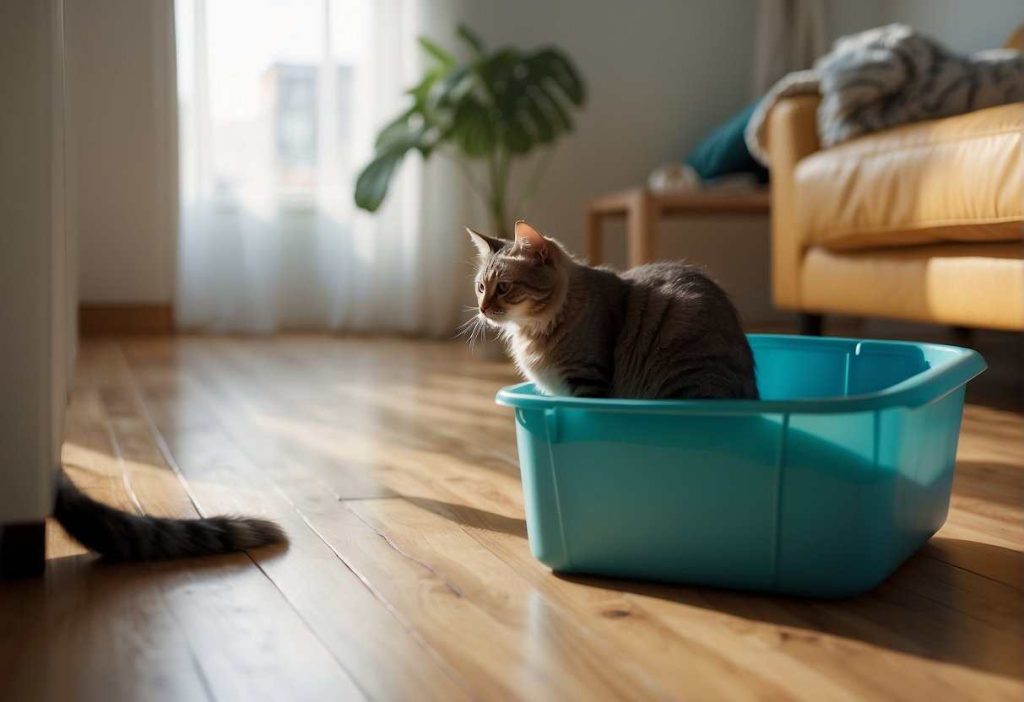
Ever felt like you’re constantly battling against your feline friend’s litter box? Apartment living doesn’t have to mean litter box woes.
Let’s talk about some nifty solutions that’ll make managing that little sandbox a breeze.
Option 1: Self-Cleaning Litter Boxes
Have you heard about self-cleaning litter boxes? They’re almost like magic. Here’s how they work:
- After your cat does their business, sensors trigger a cleaning cycle.
- A rake sifts through the litter, scooping clumps into a sealed waste compartment.
- Fresh litter is left behind, ready for the next use.
Benefits:
- Time-saving: No more daily scooping!
- Odor control: Waste is promptly removed and contained.
- Hygienic: Reduces the buildup of bacteria.
1) Litter-Robot
This high-tech litter box separates waste from clean litter, depositing clumps into a lined drawer for easy disposal.

2) ScoopFree:
A less hands-on approach where waste is raked into a concealed compartment after your cat exits.

Got it? Great! Just remember that they can be pricier upfront, but think about the time you’ll save.
Option 2: Disposable Litter Box Options
Sometimes, you’ve just got too much on your plate. That’s where disposable litter boxes come into play. They’re perfect for:
- Travel: Bring them along for stress-free trips.
- Emergencies: When you need a quick and clean setup.
- Temporary solutions: Perfect when you’re in between regular boxes.
Here’s how to use them effectively:
- Place the disposable box where your cat is trained to go.
- Once it gets full, simply throw the whole thing away.
- Replace it with a new one as needed.
No muss, no fuss.
Remember, while innovative solutions can be a game-changer, always choose what works best for you and your cat’s lifestyle.
Happy scooping… or not, if you go self-cleaning!
Odor Control Strategies
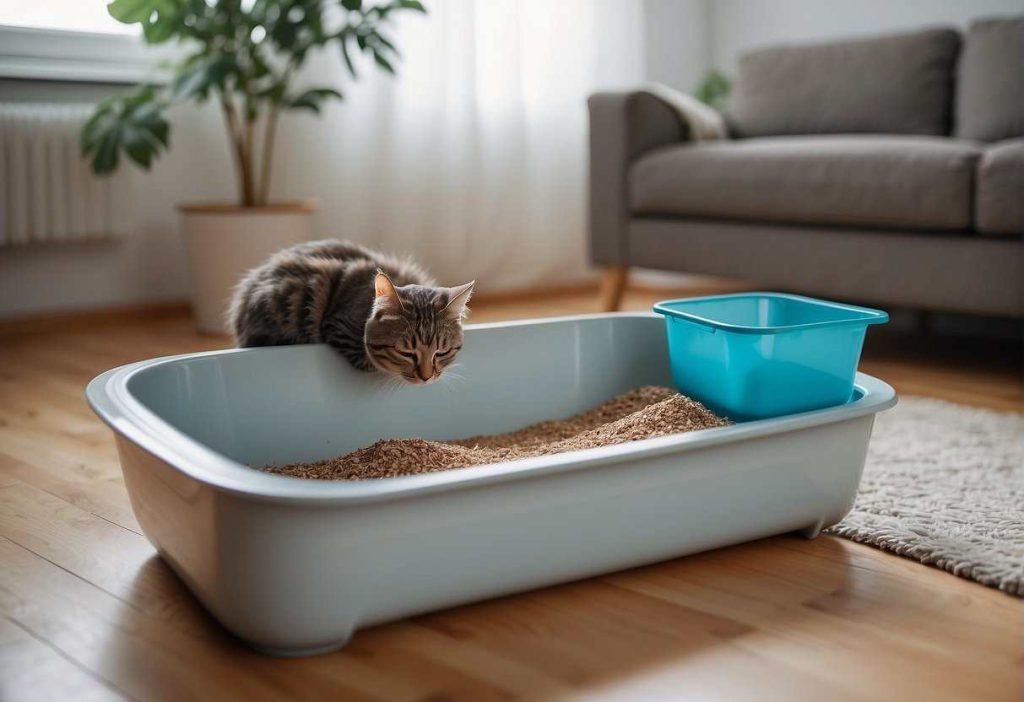
Ever stepped into someone’s apartment and thought, “Wow, did a flower shop explode in here?” No? Well, that’s the dream when you’ve got a feline friend and a litter box to maintain.
Let’s turn that dream into your reality with some nifty odor control strategies!
Choosing the Right Litter:
Here’s the scoop – not all litters are created equal when it comes to odor control.
Have you tried clumping litter with activated charcoal or baking soda? These ingredients work like a charm, trapping odors and making clean-up a breeze. A flushable litter would be a good option too.
Types of litter for minimizing odors:
- Clumping litter with activated charcoal (5)
- Baking soda-infused litter (6)
- Silica gel litter
- Natural plant-based litter (like pine or corn) (7)
Natural Odor Eliminators:
Why not go the extra mile with some home-spun remedies? Products you can find around the house or at your local store can work wonders.
How about a sprinkle of baking soda directly in the litter? Or maybe setting up a small charcoal filter near the litter box area?
Products to keep things fresh:
- Baking soda
- Charcoal filters
- Essential oil diffusers (with pet-safe oils)
- Open windows for natural ventilation
When it comes to keeping your space olfactory-friendly, implementing these strategies can lead to a freshness that’ll make your living quarters the envy of pet parents everywhere.
Remember, it’s about staying on top of the game with the right products and regular maintenance.
Now, who’s ready to turn their litter box woes into wows? Say goodbye to the “eww” and hello to a home that smells just delightful.
Cost-Effective Options and DIY Solutions
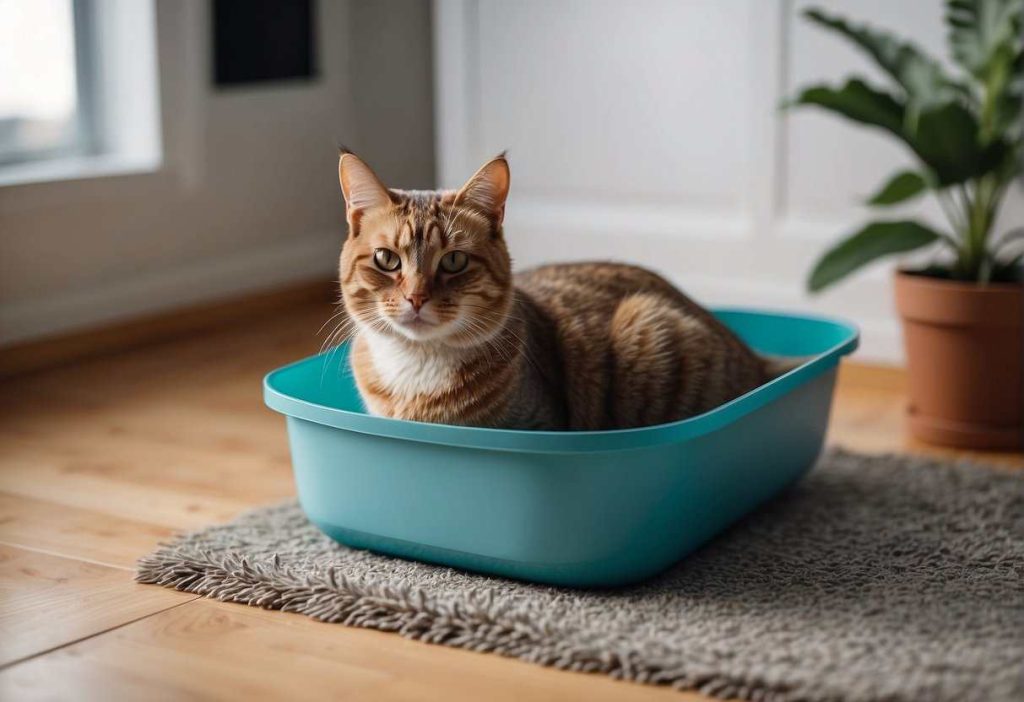
Here’s a little secret: a perfectly clean litter box need not cost a fortune.
Budget-Friendly Solutions
You might wonder if there’s a magic bullet for cost-effective litter box cleaning. Well, yes and no.
It’s not magic, but strategy. Check these out:
- Baking Soda: An open box of baking soda placed near the litter box can help absorb odors.
- DIY Deodorizer: Sprinkle a mixture of baking soda and ground coffee in the bottom of the litter box before adding litter.
- Vinegar: A cheap and natural way to clean the box. Mix it with water for a safe, effective wash.
Make a price-to-practicality comparison and choose what suits your pocket and your cat’s preference.
DIY Litter Box Management
Who knew that your old stuff could come to the rescue? Repurpose with purpose:
- Disposable Sponges: Why buy pricey wipes when a disposable sponge does the trick? Use it once and toss it away.
- Old Newspapers: Shred them up and use them as a temporary litter box liner.
- Homemade Scoop: A used plastic container with holes can double as a scoop.
Be mindful that repurposing shouldn’t compromise hygiene.
Keep it clean and your kitty will be ever so thankful.
Remember, sometimes the simplest solutions are right in front of you, or under your sink!
Comparative Analysis of Litter Types
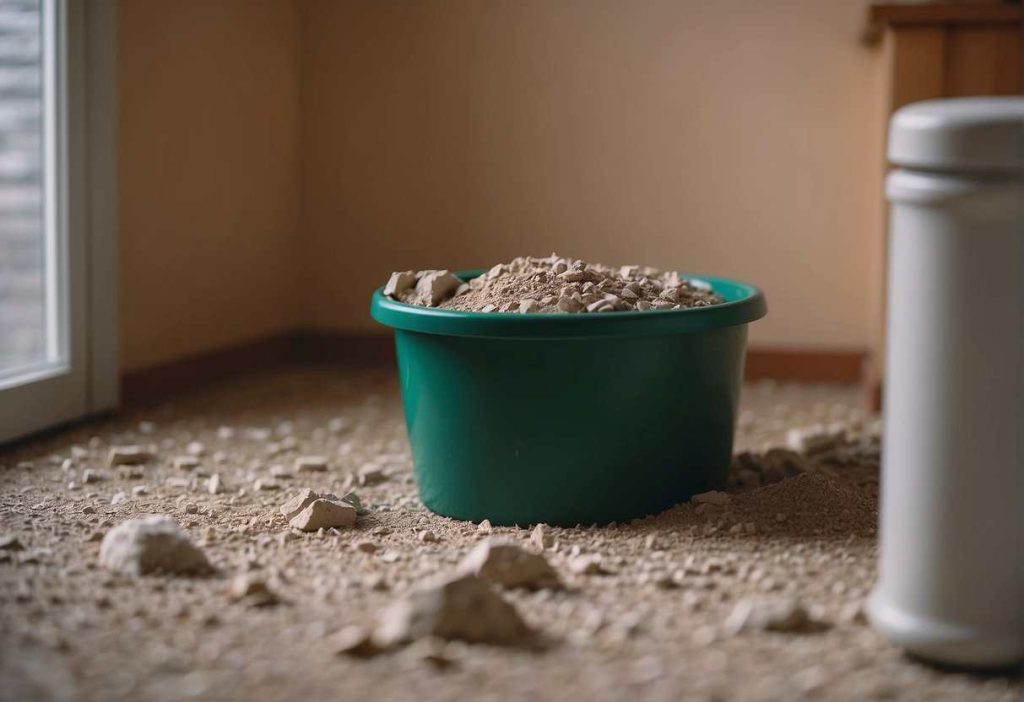
Let’s walk through the different kinds of litter to help you pinpoint which one’s the right fit for both of you.
Clay Clumping Litter
Pros:
- Easy to scoop: Clumps solidly, making it simple to remove waste.
- Cost-effective: Generally less expensive than other types.
Cons:
- Heavy: Can be difficult to lug around, especially if you’re lacking an elevator.
- Dusty: May cause respiratory issues for sensitive cats and humans.
Silica Gel Crystals
Pros:
- Highly absorbent: Keeps moisture at bay, reducing odors.
- Lightweight: A dream to carry, particularly in a tiny apartment.
Cons:
- Pricey: Tends to be on the steeper side, cost-wise.
- Less clumping: Not everyone’s cup of tea when it comes to scooping.
Biodegradable Litter
Pros:
- Eco-friendly: Made from recycled paper, wood, or even corn.
- Flushable: Some types can go directly into the toilet—easy peasy!
Cons:
- Variable absorption: Not all brands are created equal in odor control.
- Can be costly: Often pricier than your standard clumping clay.
Here’s a quick snapshot to digest the details:
| Type | Pros | Cons |
| Clay Clumping | Easy to scoop; Cost-effective | Heavy; Dusty |
| Silica Gel | Absorbent; Lightweight | More expensive; Less Clumping |
| Biodegradable | Eco-friendly; Flushable | Variable absorption; Can be costly |
Remember, what works wonders for one cat-owner duo may not hit the mark for another.
Think about your feline’s habits, your cleaning preferences, and yes, even that pesky apartment size when making your choice.
Happy scooping!
Integrating Litter Boxes into Your Decor
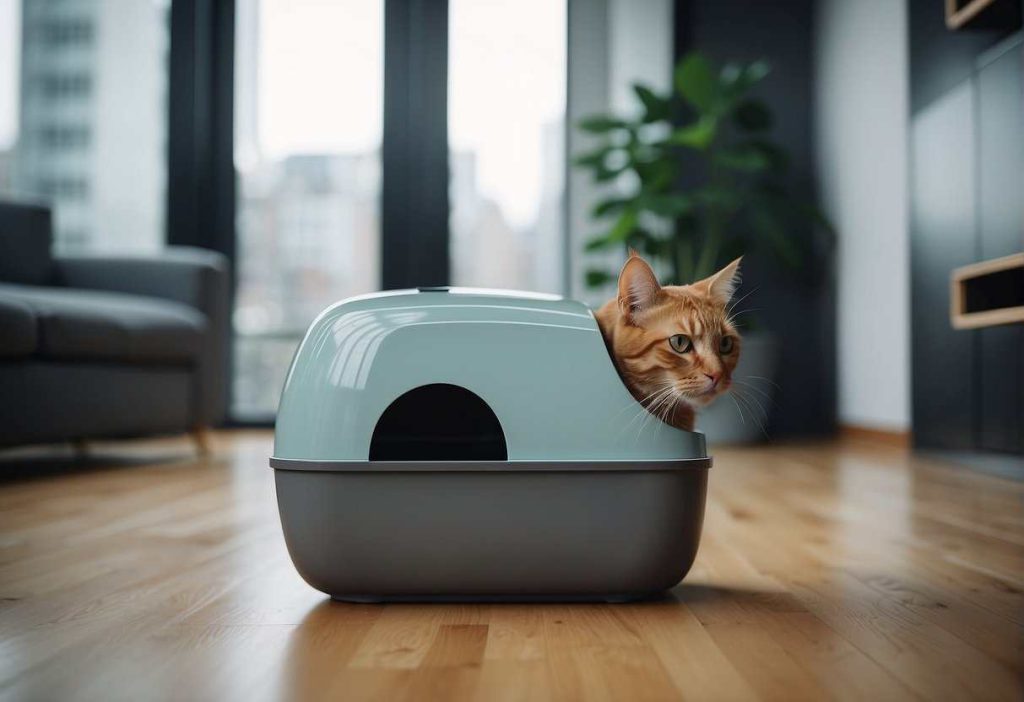
Thinking of how to make that cat litter box a little less of an eyesore in your apartment? Let’s get creative and find solutions, just for you!
Creative Solutions for Small Spaces
Small apartment? No problem! It’s all about making the most of what you’ve got.
- Multi-functional Furniture: How about a bench that also hides your cat’s litter box? Handy for seating and cleverly conceals your kitty’s private space.
- Discreet Placement: Slot that litter box under a desk, or tuck it into a corner. Maybe even hide it in plain sight with a stylish cover that matches your decor.
Personalizing Your Litter Box Area
It’s your space, so let’s personalize it.
- Tailor to Your Aesthetics: Choose a litter box cover that vibes with your decor. Love minimalism? Go for clean lines and neutral colors.
- Consider Your Cat’s Needs: You know your furry friend best. Top-entry or side-entry? They’ll let you know their preference.
Transforming your litter box area is not just about blending in with your decor, but also about addressing practicality without sacrificing style.
Now, who said a litter box can’t be both functional and chic?
Strategies for Extremely Limited Spaces
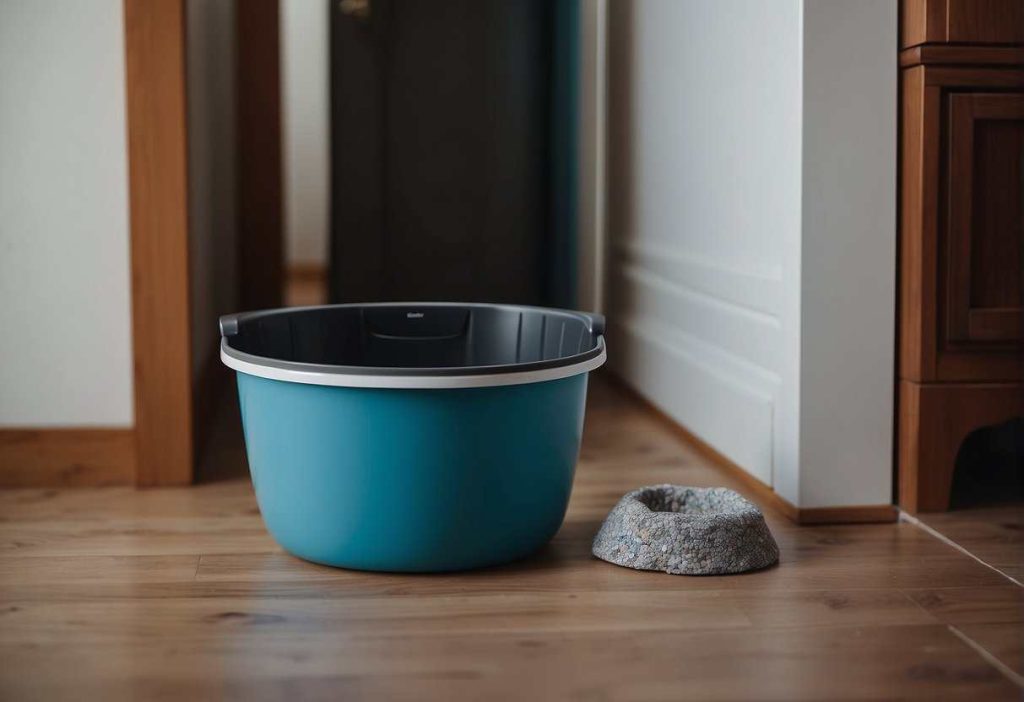
Ever feel like your apartment is a tiny jungle and your cat’s litter box is the mysterious cave hidden within it? Well, you’re not alone!
Keeping a litter box clean and odor-free in a space not much bigger than a shoebox is a challenge, but it’s nothing you can’t handle.
Maximizing Small Living Areas
Finding the perfect spot for the litter box in your apartment is like a game of Tetris but with higher stakes!
The key is to find a low-traffic corner to keep it out of sight and reduce the spread of odors.
Do you have a bathroom that can spare a square foot or two? Perfect! Or maybe a tiny balcony where the litter box can hang out? Just be sure it’s protected from the weather.
Specific strategies for odor control:
- Utilize odor-absorbing materials like baking soda at the bottom of the pan.
- Clean up promptly — frequent scooping makes a world of difference.
- Consider air purifiers or a small fan to keep the air moving.
Accommodating Multiple Cats
If you’ve got a feline duo or trio, the litter box situation can quickly multiply. You need a strategy!
- Invest in space-saving litter boxes that can be easily tucked away.
- Stackable litter boxes are a thing — look for designs that make use of vertical space.
- Scheduling litter maintenance can manage odors with precision before they arise.
For all your cat lovers in cramped quarters, remember: that size doesn’t limit the love. It only makes us more creative in keeping our little wildlings and their thrones spick and span!
Personalization of Litter Box Solutions
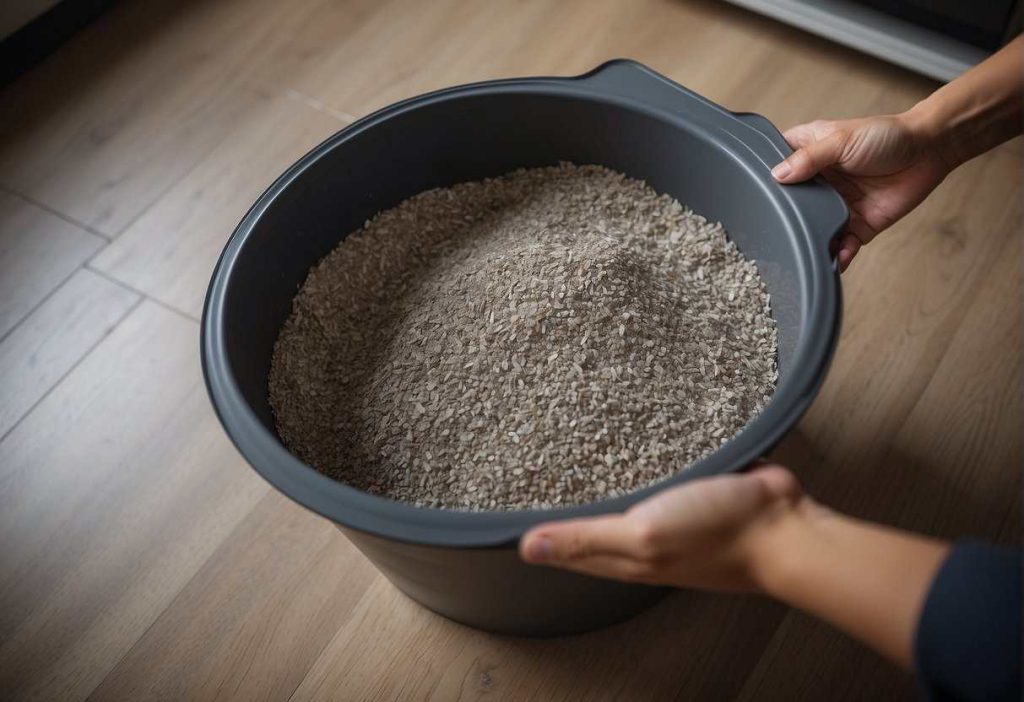
Cats have their own unique tastes and quirks, just like us humans. So, let’s chat about catering to your cat’s preferences when it comes to their bathroom setup.
Firstly, consider the type of litter box that suits your kitty.
Is your cat a private feline? A covered box could be their safe haven. More of a free spirit? An open box might be more their style.
Remember, size matters too! Make sure it’s spacious enough for them to turn around comfortably.
Choosing the right litter is equally essential.
Cats can be quite the critics, so if they turn up their nose at your selection, it might be time to switch it up. Here’s a simple breakdown to help you decide:
- Clumping or Non-clumping: Cats typically prefer clumping, but you might prefer the ease of non-clumping.
- Scented or Unscented: While humans love fresh scents, many cats prefer unscented options.
- Natural or Synthetic: Some cats and owners prefer natural materials like pine or wheat.
To control odor in your apartment, consider:
- Baking Soda: A sprinkle at the bottom of the box for natural odor control.
- Frequent Scooping: Keeping the box clean encourages your cat to use it.
Remember, your cat’s comfort with their litter box influences their happiness and health.
It’s worth taking the time to discover what they love. Your nose – and your furry companion – will thank you!
Quick Recap

Got your gloves and scoop ready? Let’s do a swift run-through of the steps for keeping your feline’s throne spick and span:
- Preparation: Round up your cleaning arsenal:
- Gloves
- Litter scooper
- Trash bags
- Cat-safe disinfectant
- Scrub brush
- Paper towels or rags
- Baking soda (for that extra freshness)
- Scooping: Daily diligence pays off!
- Keep those clumps and waste out daily – it’s a breeze and keeps odors at bay.
- Deep Clean: About once a week, empty and scrub that box.
- A mix of warm water and a cat-safe disinfectant does wonders. Rinse well!
- Drying: Thoroughly dry the litter box to prevent moisture from turning into a smelly tale.
- Refilling: Sprinkle a touch of baking soda at the bottom, then refill with fresh litter.
- And voilà, you’re done!
Consistent maintenance not only keeps your nose from staging a protest but also encourages your kitty to use their spot.
Remember, a clean litter box is a happy litter box, and a happy litter box leads to a happy kitty. Keep it up, and both you and your four-legged pal will be purring with satisfaction!
Frequently Asked Questions
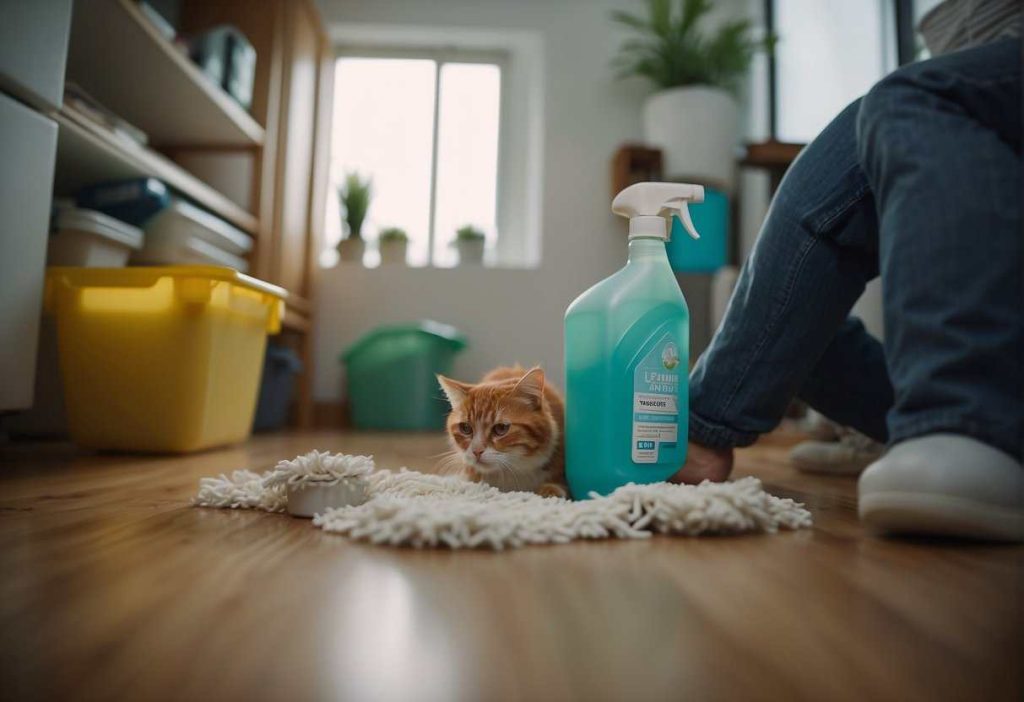
Navigating litter box maintenance in an apartment setting brings up some common queries. Let’s tackle your most pressing questions to maintain a fresh and clean space for both you and your cat.
How often should I clean my cat’s litter box in a small apartment?
You should scoop out waste daily and do a full clean by replacing the litter at least once a week.
In a smaller space, timely cleaning is crucial to control odors and promote a healthy environment for your cat.
What are the best types of litter for controlling odor in a small space?
Clumping litter made from bentonite clay is excellent for odor control and easy cleanup.
Alternatively, silica gel crystals are highly absorbent and can effectively trap odors.
Can I use household products to eliminate litter box odors?
Certainly! Baking soda can be sprinkled into the litter for natural odor control.
However, avoid strong chemicals or scented sprays that could irritate your cat or mask odors without eliminating them.
Are self-cleaning litter boxes worth the investment for apartment dwellers?
Self-cleaning litter boxes automate the scooping process and can be a convenient choice for a small apartment.
They are higher in cost but can save time and help keep the litter box fresh between manual cleanings.
How can I discreetly integrate a litter box into my small apartment?
Consider furniture that doubles as a litter box enclosure.
This can discreetly integrate your cat’s litter box into your living space while containing odors and litter scatter.
What are some effective DIY solutions for litter box management in an apartment?
Create a dedicated litter box zone with a mat to catch loose litter and use a plastic storage container as a cost-effective, customizable litter box.
Regularly clean the mat and area around the box to minimize mess.
How can I prevent litter tracking throughout my apartment?
Use a litter box with high sides to minimize kicking out litter during use.
Placing a litter mat with a textured surface outside the box can also catch litter from your cat’s paws as they exit.

